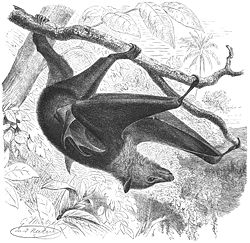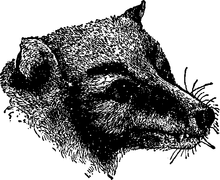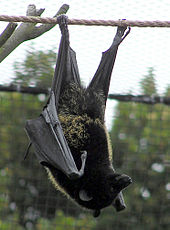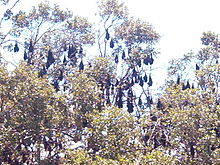- Megabat
-
"Fruit bat" redirects here. For other uses, see Fruit Bat (disambiguation).
Megabats
Temporal range: Oligocene–Recent
Large flying fox, Pteropus vampyrus Scientific classification Kingdom: Animalia Phylum: Chordata Class: Mammalia Order: Chiroptera Suborder: Megachiroptera or Yinpterochiroptera
Dobson, 1875Family: Pteropodidae
Gray, 1821Subfamilies Nyctimeninae
Cynopterinae
Harpiyonycterinae
Macroglossinae
Pteropodinae
Rousettinae
EpomophorinaeMegabats constitute the suborder Megachiroptera, family Pteropodidae of the order Chiroptera (bats). They are also called fruit bats, old world fruit bats, or flying foxes.
Contents
Description
 Spectacled Flying-fox (Pteropus conspicillatus)
Spectacled Flying-fox (Pteropus conspicillatus)
The megabat, contrary to its name, is not always large: the smallest species is 6 centimetres (2.4 in) long and thus smaller than some microbats.[citation needed] The largest reach 40 centimetres (16 in) in length and attain a wingspan of 150 centimetres (4.9 ft), weighing in at nearly 1 kilogram (2.2 lb). Most fruit bats have large eyes, allowing them to orient visually in the twilight of dusk and inside caves and forests.
Their sense of smell is excellent. In contrast to the microbats, the fruit bats do not use echolocation (with one exception, the Egyptian fruit bat Rousettus egyptiacus, which uses high-pitched clicks to navigate in caves).
Behaviour and ecology
Megabats are frugivorous or nectarivorous, i.e., they eat fruits or lick nectar from flowers. Often the fruits are crushed and only the juices consumed. The teeth are adapted to bite through hard fruit skins. Large fruit bats must land in order to eat fruit, while the smaller species are able to hover with flapping wings in front of a flower or fruit.[citation needed]
Frugivorous bats aid the distribution of plants (and therefore, forests) by carrying the fruits with them and spitting the seeds or eliminating them elsewhere. Nectarivores actually pollinate visited plants. They bear long tongues that are inserted deep into the flower; pollen thereby passed to the bat is then transported to the next blossom visited, pollinating it. This relationship between plants and bats is a form of mutualism known as chiropterophily. Examples of plants that benefit from this arrangement include the baobabs of the genus Adansonia and the sausage tree (Kigelia).
Classification
 Head of a Masked Flying Fox or Fruit-Bat (Pteropus personatus).
Head of a Masked Flying Fox or Fruit-Bat (Pteropus personatus).
 Livingstone's Fruit Bat Pteropus livingstonii
Livingstone's Fruit Bat Pteropus livingstonii
Bats are usually thought to belong to one of two monophyletic groups, a view that is reflected in their classification into two suborders (Megachiroptera and Microchiroptera). According to this hypothesis, all living megabats and microbats are descendants of a common ancestor species that was already capable of flight.
However, there have been other views, and a vigorous debate persists to this date. For example, in the 1980s and 1990s, some researchers proposed (based primarily on the similarity of the visual pathways) that the Megachiroptera were in fact more closely affiliated with the primates than the Microchiroptera, with the two groups of bats having therefore evolved flight via convergence (see Flying primates theory).[1] However, a recent flurry of genetic studies confirms the more longstanding notion that all bats are indeed members of the same clade, the Chiroptera.[2][3] Other studies have recently suggested that certain families of microbats (possibly the horseshoe bats, mouse-tailed bats and the false vampires) are evolutionarily closer to the fruit bats than to other microbats.[2][4]
List of species
The family Pteropodidae is divided into seven subfamilies with 186 total extant species, represented by 44 - 46 genera:
FAMILY PTEROPODIDAE
- Subfamily Nyctimeninae
- Genus Nyctimene - tube-nosed fruit bats
- Broad-striped Tube-nosed Fruit Bat, Nyctimene aello
- Common Tube-nosed Fruit Bat, Nyctimene albiventer
- Pallas's Tube-nosed Fruit Bat, Nyctimene cephalotes
- Dark Tube-nosed Fruit Bat, Nyctimene celaeno
- Mountain Tube-nosed Fruit Bat, Nyctimene certans
- Round-eared Tube-nosed Fruit Bat, Nyctimene cyclotis
- Dragon Tube-nosed Fruit Bat, Nyctimene draconilla
- Keast's Tube-nosed Fruit Bat, Nyctimene keasti
- Island Tube-nosed Fruit Bat, Nyctimene major
- Malaita Tube-nosed Fruit Bat, Nyctimene malaitensis
- Demonic Tube-nosed Fruit Bat, Nyctimene masalai
- Lesser Tube-nosed Bat, Nyctimene minutus
- Philippine Tube-nosed Fruit Bat, Nyctimene rabori
- Eastern Tube-nosed Bat, Nyctimene robinsoni
- Nendo Tube-nosed Fruit Bat, Nyctimene sanctacrucis (early 20th century †)
- Umboi Tube-nosed Fruit Bat, Nyctimene vizcaccia
- Genus Paranyctimene
- Lesser Tube-nosed Fruit Bat, Paranyctimene raptor
- Steadfast Tube-nosed Fruit Bat, Paranyctimene tenax
- Genus Nyctimene - tube-nosed fruit bats
- Subfamily Cynopterinae
- Genus Aethalops - pygmy fruit bats
- Borneo Fruit Bat, Aethalops aequalis
- Pygmy Fruit Bat, Aethalops alecto
- Genus Alionycteris
- Mindanao Pygmy Fruit Bat, Alionycteris paucidentata
- Genus Balionycteris
- Spotted-winged Fruit Bat, Balionycteris maculata
- Genus Chironax
- Black-capped Fruit Bat, Chironax melanocephalus
- Genus Cynopterus - dog-faced fruit bats or short-nosed fruit bats
- Lesser Short-nosed Fruit Bat, Cynopterus brachyotis
- Horsfield’s Fruit Bat, Cynopterus horsfieldii
- Peters’s Fruit Bat, Cynopterus luzoniensis
- Minute Fruit Bat, Cynopterus minutus
- Nusatenggara Short-nosed Fruit Bat, Cynopterus nusatenggara
- Greater Short-nosed Fruit Bat, Cynopterus sphinx
- Indonesian Short-nosed Fruit Bat, Cynopterus titthaecheilus
- Genus Dyacopterus - Dayak fruit bats
- Brooks’s Dyak Fruit Bat, Dyacopterus brooksi
- Rickart's Dyak Fruit Bat, Dyacopterus rickarti
- Dayak Fruit Bat, Dyacopterus spadiceus
- Genus Haplonycteris
- Fischer's Pygmy Fruit Bat, Haplonycteris fischeri
- Genus Latidens
- Salim Ali's Fruit Bat, Latidens salimalii
- Genus Megaerops
- Tailess Fruit Bat, Megaerops ecaudatus
- Javan Tailless Fruit Bat, Megaerops kusnotoi
- Ratanaworabhan's Fruit Bat, Megaerops niphanae
- White-collared Fruit Bat, Megaerops wetmorei
- Genus Otopteropus
- Luzon Fruit Bat, Otopteropus cartilagonodus
- Genus Penthetor
- Dusky Fruit Bat, Penthetor lucasi
- Genus Ptenochirus - musky fruit bats
- Greater Musky Fruit Bat, Ptenochirus jagori
- Lesser Musky Fruit Bat, Ptenochirus minor
- Genus Sphaerias
- Blanford's Fruit Bat, Sphaerias blanfordi
- Genus Thoopterus
- Swift Fruit Bat, Thoopterus nigrescens
- Genus Aethalops - pygmy fruit bats
- Subfamily Harpiyonycterinae
- Genus Aproteles
- Bulmer's Fruit Bat, Aproteles bulmerae
- Genus Dobsonia - bare-backed fruit bats
- Andersen's Bare-backed Fruit Bat, Dobsonia anderseni
- Beaufort's Naked-backed Fruit Bat, Dobsonia beauforti
- Philippine Bare-backed Fruit Bat, Dobsonia chapmani
- Halmahera Naked-backed Fruit Bat, Dobsonia crenulata
- Biak Naked-backed Fruit Bat, Dobsonia emersa
- Sulawesi Naked-backed Fruit Bat, Dobsonia exoleta
- Solomon's Naked-backed Fruit Bat, Dobsonia inermis
- Lesser Naked-backed Fruit Bat, Dobsonia minor
- Moluccan Naked-backed Fruit Bat, Dobsonia moluccensis
- Panniet Naked-backed Fruit Bat, Dobsonia pannietensis
- Western Naked-backed Fruit Bat, Dobsonia peroni
- New Britain Naked-backed Fruit Bat, Dobsonia praedatrix
- Greenish Naked-backed Fruit Bat, Dobsonia viridis
- Genus Harpyionycteris
- Sulawesi Harpy Fruit Bat, Harpyionycteris celebensis
- Harpy Fruit Bat, Harpyionycteris whiteheadi
- Genus Aproteles
- Subfamily Macroglossinae
- Genus Macroglossus - long-tongued fruit bats
- Long-tongued Nectar Bat, Macroglossus minimus
- Long-tongued Fruit Bat, Macroglossus sobrinus
- Genus Melonycteris
- Fardoulis' Blossom Bat, Melonycteris fardoulisi
- Black-bellied Fruit Bat, Melonycteris melanops
- Woodford's Fruit Bat, Melonycteris woodfordi
- Genus Notopteris - long-tailed fruit bats
- Long-tailed Fruit Bat, Notopteris macdonaldi (Fiji and Vanuatu)
- New Caledonia Blossom Bat, Notopteris neocaledonica (New Caledonia)
- Genus Syconycteris - blossom bats
- Common Blossom Bat, Syconycteris australis
- Halmahera Blossom Bat, Syconycteris carolinae
- Moss-forest Blossom Bat, Syconycteris hobbit
- Genus Macroglossus - long-tongued fruit bats
- Subfamily Pteropodinae
- Genus Acerodon
- Sulawesi Flying Fox, Acerodon celebensis
- Talaud Flying Fox, Acerodon humilis
- Giant Golden-crowned Flying Fox, Acerodon jubatus
- Palawan Fruit Bat, Acerodon leucotis
- Panay Giant Fruit Bat, Acerodon lucifer (1996 †)
- Sunda Flying Fox, Acerodon mackloti
- Genus Desmalopex
- White-winged Flying Fox, Desmalopex leucopterus
- Small White-winged Flying Fox, Desmalopex microleucopterus
- Genus Eidolon - straw-coloured fruit bats
- Madagascan Fruit Bat, Eidolon dupreanum
- Straw-coloured Fruit Bat, Eidolon helvum
- Genus Mirimiri
- Fijian Monkey-faced Bat, Mirimiri acrodonta
- Genus Neopteryx
- Small-toothed Fruit Bat, Neopteryx frosti
- Genus Pteralopex
- Bougainville Monkey-faced Bat, Pteralopex anceps
- Guadalcanal Monkey-faced Bat, Pteralopex atrata
- Greater Monkey-faced Bat, Pteralopex flanneryi
- Montane Monkey-faced Bat, Pteralopex pulchra
- New Georgian Monkey-faced Bat, Pteralopex taki
- Genus Pteropus - flying foxes
- P. alecto species group
- Black Flying Fox, Pteropus alecto
- P. caniceps species group
- Ashy-headed Flying Fox, Pteropus caniceps
- P. chrysoproctus species group
- Silvery Flying Fox, Pteropus argentatus
- Moluccan Flying Fox, Pteropus chrysoproctus
- Makira Flying Fox, Pteropus cognatus
- Banks Flying Fox, Pteropus fundatus
- Solomons Flying Fox, Pteropus rayneri
- Rennell Flying Fox, Pteropus rennelli
- P. conspicillatus species group
- Spectacled Flying Fox, Pteropus conspicillatus
- Ceram Fruit Bat, Pteropus ocularis
- P. livingstonii species group
- Aru Flying Fox, Pteropus aruensis
- Kei Flying Fox, Pteropus keyensis
- Livingstone's Fruit Bat, Pteropus livingstonii
- Black-bearded Flying Fox, Pteropus melanopogon
- P. mariannus species group
- Okinawa Flying Fox, Pteropus loochoensis
- Mariana Fruit Bat, Pteropus mariannus
- Pelew Flying Fox, Pteropus pelewensis
- Kosrae Flying Fox, Pteropus ualanus
- Yap Flying Fox, Pteropus yapensis
- P. melanotus species group
- Black-eared Flying Fox, Pteropus melanotus
- P. molossinus species group
- Lombok Flying Fox, Pteropus lombocensis
- Caroline Flying Fox, Pteropus molossinus
- Rodrigues Flying Fox, Pteropus rodricensis
- P. neohibernicus species group
- Bismarck Flying Fox, Pteropus neohibernicus
- P. niger species group
- Aldabra Flying Fox, Pteropus aldabrensis
- Mauritian Flying Fox, Pteropus niger
- Madagascan Flying Fox, Pteropus rufus
- Seychelles Fruit Bat, Pteropus seychellensis
- Pemba Flying Fox, Pteropus voeltzkowi
- P. personatus species group
- Bismark Masked Flying Fox, Pteropus capistratus
- Masked Flying Fox, Pteropus personatus
- Temminck's Flying Fox, Pteropus temminckii
- P. poliocephalus species group
- Big-eared Flying Fox, Pteropus macrotis
- Geelvink Bay Flying Fox, Pteropus pohlei
- Grey-headed Flying Fox, Pteropus poliocephalus
- P. pselaphon species group
- Chuuk Flying Fox, Pteropus insularis
- Temotu Flying Fox, Pteropus nitendiensis
- Large Palau Flying Fox, Pteropus pilosus (19th century †)
- Bonin Flying Fox, Pteropus pselaphon
- Guam Flying Fox, Pteropus tokudae (1970s †)
- Insular Flying Fox, Pteropus tonganus
- Vanikoro Flying Fox, Pteropus tuberculatus
- New Caledonia Flying Fox, Pteropus vetulus
- P. samoensis species group
- Vanuatu Flying Fox, Pteropus anetianus
- Samoa Flying Fox, Pteropus samoensis
- P. scapulatus species group
- Gilliard's Flying Fox, Pteropus gilliardorum
- Lesser Flying Fox, Pteropus mahaganus
- Little Red Flying Fox, Pteropus scapulatus
- Dwarf Flying Fox, Pteropus woodfordi
- P. subniger species group
- Admiralty Flying Fox, Pteropus admiralitatum
- Dusky Flying Fox, Pteropus brunneus (19th century †)
- Ryukyu Flying Fox, Pteropus dasymallus
- Nicobar Flying Fox, Pteropus faunulus
- Gray Flying Fox, Pteropus griseus
- Ontong Java Flying Fox, Pteropus howensis
- Small Flying Fox, Pteropus hypomelanus
- Ornate Flying Fox, Pteropus ornatus
- Little Golden-mantled Flying Fox, Pteropus pumilus
- Philippine Gray Flying Fox, Pteropus speciosus
- Small Mauritian Flying Fox, Pteropus subniger (19th century †)
- P. vampyrus species group
- Indian Flying Fox, Pteropus giganteus
- Andersen's Flying Fox, Pteropus intermedius
- Lyle's Flying Fox, Pteropus lylei
- Large Flying Fox, Pteropus vampyrus
- incertae sedis
- Small Samoan Flying Fox, Pteropus allenorum (19th century †)
- Large Samoan Flying Fox, Pteropus coxi (19th century †)
- P. alecto species group
- Genus Styloctenium
- Mindoro Stripe-faced Fruit Bat, Styloctenium mindorensis
- Sulawesi Stripe-faced Fruit Bat, Styloctenium wallacei
- Genus Acerodon
- Subfamily Rousettinae
- Genus Eonycteris - dawn fruit bats
- Greater Nectar Bat, Eonycteris major
- Cave Nectar Bat, Eonycteris spelaea
- Philippine Dawn Bat, Eonycteris robusta
- Genus Rousettus - rousette fruit bats
- Subgenus Boneia
- Manado Fruit Bat, Rousettus (Boneia) bidens
- Subgenus Rousettus
- Geoffroy's Rousette, Rousettus amplexicaudatus
- Sulawesi Rousette, Rousettus celebensis
- Egyptian Rousette (Egyptian Fruit Bat), Rousettus aegyptiacus
- Leschenault's Rousette, Rousettus leschenaulti
- Linduan Rousette, Rousettus linduensis
- Comoro Rousette, Rousettus obliviosus
- Bare-backed Rousette, Rousettus spinalatus
- Subgenus Stenonycteris
- Long-haired Rousette, Rousettus (Stenonycteris) lanosus
- Madagascar Rousette, Rousettus (Stenonycteris) madagascariensis
- Subgenus Boneia
- Genus Eonycteris - dawn fruit bats
- Subfamily Epomophorinae
- Tribe Epomophorini
- Genus Epomophorus - epauletted fruit bats
- Angolan Epauletted Fruit Bat, Epomophorus angolensis
- Ansell's Epauletted Fruit Bat, Epomophorus anselli
- Peters's Epauletted Fruit Bat, Epomophorus crypturus
- Gambian Epauletted Fruit Bat, Epomophorus gambianus
- Lesser Angolan Epauletted Fruit Bat, Epomophorus grandis
- Ethiopian Epauletted Fruit Bat, Epomophorus labiatus
- East African Epauletted Fruit Bat, Epomophorus minimus
- Minor Epauletted Fruit Bat, Epomophorus minor
- Wahlberg's Epauletted Fruit Bat, Epomophorus wahlbergi
- Genus Epomops - epauletted bats
- Buettikofer's Epauletted Fruit Bat, Epomops buettikoferi
- Dobson's Fruit Bat, Epomops dobsoni
- Franquet's Epauletted Fruit Bat, Epomops franqueti
- Genus Hypsignathus
- Hammer-headed Bat, Hypsignathus monstrosus
- Genus Micropteropus - dwarf epauletted bats
- Hayman's Dwarf Epauletted Fruit Bat, Micropteropus intermedius
- Peter's Dwarf Epauletted Fruit Bat, Micropteropus pusillus
- Genus Nanonycteris
- Veldkamp's Dwarf Epauletted Fruit Bat, Nanonycteris veldkampii
- Genus Epomophorus - epauletted fruit bats
- Tribe Myonycterini
- Genus Lissonycteris
- Angolan Rousette, Lissonycteris angolensis
- Genus Megaloglossus
- Woermann's Bat, Megaloglossus woermanni
- Genus Myonycteris - little collared fruit bats
- São Tomé Collared Fruit Bat, Myonycteris brachycephala
- East African Little Collared Fruit Bat, Myonycteris relicta
- Little Collared Fruit Bat, Myonycteris torquata
- Genus Lissonycteris
- Tribe Plerotini
- Genus Plerotes
- D'Anchieta's Fruit Bat, Plerotes anchietae
- Genus Plerotes
- Tribe Scotonycterini
- Genus Casinycteris
- Short-palated Fruit Bat, Casinycteris argynnis
- Genus Scotonycteris
- Zenker's Fruit Bat, Scotonycteris zenkeri
- Pohle's Fruit Bat, Scotonycteris ophiodon
- Genus Casinycteris
- Tribe Epomophorini
As disease reservoirs
Fruit bats have been found to act as reservoirs for a number of diseases which can prove fatal to humans and domestic animals such as horses[citation needed]. The bats themselves sometimes have no signs of infection.
Researchers tested fruit bats for the presence of the Ebola virus between 2001 and 2003. Three species of bats tested positive for Ebola, but had no symptoms of the virus[citation needed]. This indicates that the bats may be acting as a reservoir for the virus. Of the infected animals identified during these field collections, immunoglobulin G (IgG) specific for Ebola virus was detected in Hypsignathus monstrosus, Epomops franqueti, and Myonycteris torquata.
The epidemical Marburg virus was found in 2007 in specimens of the Egyptian fruit bat, confirming the suspicion that this species may be a reservoir for this dangerous virus.[5]
Fruit bats are considered a delicacy by South Pacific Islanders, where consumption has been suggested as a possible cause of Lytico-Bodig disease.[6]
Other diseases which can be carried by fruit bats include Australian bat lyssavirus and Henipavirus (notably Hendra virus and Nipah virus), both of which can prove fatal to humans.
Footnotes
- ^ Pettigrew JD, Jamieson BG, Robson SK, Hall LS, McAnally KI, Cooper HM (1989). "Phylogenetic relations between microbats, megabats and primates (Mammalia: Chiroptera and Primates)". Philosophical Transactions of the Royal Society of London, Series B, Biological Sciences 325 (1229): 489–559. doi:10.1098/rstb.1989.0102.
- ^ a b Eick, GN; Jacobs, DS; Matthee, CA (September 2005). "A nuclear DNA phylogenetic perspective on the evolution of echolocation and historical biogeography of extant bats (chiroptera)" (Free full text). Molecular biology and evolution 22 (9): 1869–86. doi:10.1093/molbev/msi180. PMID 15930153. http://mbe.oxfordjournals.org/cgi/pmidlookup?view=long.
- ^ Simmons, NB; Seymour, KL; Habersetzer, J; Gunnell, GF (2008-02-14). "Primitive Early Eocene bat from Wyoming and the evolution of flight and echolocation". Nature 451 (7180): 818–21. doi:10.1038/nature06549. PMID 18270539. http://www.nature.com/nature/journal/v451/n7180/abs/nature06549.html. "recent studies unambiguously support bat monophyly"
- ^ Adkins RM, Honeycutt RL (1991). "Molecular phylogeny of the superorder Archonta" (PDF). Proceedings of the National Academy of Sciences of the U.S.A. 88 (22): 10317–10321. doi:10.1073/pnas.88.22.10317. PMC 52919. PMID 1658802. http://www.pnas.org/cgi/reprint/88/22/10317.pdf.
- ^ "Deadly Marburg virus discovered in fruit bats". msnbc. August 21, 2007. http://www.msnbc.msn.com/id/20382188/. Retrieved 2008-03-11.
- ^ Monson, C. S.; Banack, S. A.; Cox, P. A. (2003). "Conservation implications of Chamorro consumption of flying foxes as a possible cause of amyotrophic lateral sclerosis-parkinsonism dementia complex in Guam". Conservation Biology 17 (3): 678–686. doi:10.1046/j.1523-1739.2003.02049.x.
References
- Myers, P. 2001. "Pteropodidae" (On-line), Animal Diversity Web. Accessed December 26, 2006 at http://animaldiversity.ummz.umich.edu/site/accounts/information/Pteropodidae.html.
- Springer, M. S.; et al. (28 January 2005). "A Molecular Phylogeny for Bats Illuminates Biogeography and the Fossil Record". Science 307 (5709): 580–4. doi:10.1126/science.1105113. PMID 15681385.
- Leroy, M.; Kumulungui, B.; Pourrut, X.; Rouquet, P.; Hassanin, A.; Yaba, P.; Délicat, A.; Paweska, T. et al. (Dec 2005). "Fruit bats as reservoirs of Ebola virus". Nature 438 (7068): 575–576. Bibcode 2005Natur.438..575L. doi:10.1038/438575a. ISSN 0028-0836. PMID 16319873.
- Bat World Sanctuary
- Rodrigues Fruit Bats
- Bat Conservation International
- Criticism of the molecular evidence for bat monophyly
- Brief history of Megachiroptera / Megabats
External links
- Bat World Sanctuary
- Rodrigues Fruit Bats
- Bat Conservation International
- Brief history of Megachiroptera / Megabats
Chiroptera families Kingdom: Animalia · Phylum: Chordata · Class: Mammalia · Infraclass: Eutheria · Superorder: Laurasiatheria Yinpterochiroptera
(Pteropodiformes)Yangochiroptera
(Vespertilioniformes)Emballonuridae (Sac-winged bats) · Furipteridae (Smoky bats) · Miniopteridae (Long-winged bats) · Molossidae (Free-tailed bats) · Mormoopidae (Ghost-faced bats) · Mystacinidae (New Zealand short-tailed bats) · Myzopodidae (Sucker-footed bats) · Natalidae (Funnel-eared bats) · Noctilionidae (Bulldog bats) · Nycteridae (Hollow-faced bats) · Phyllostomidae (Leaf-nosed bats) · Thyropteridae (Disk-winged bats) · Vespertilionidae (Vesper bats)Categories:- Megabats
- Subfamily Nyctimeninae
Wikimedia Foundation. 2010.

